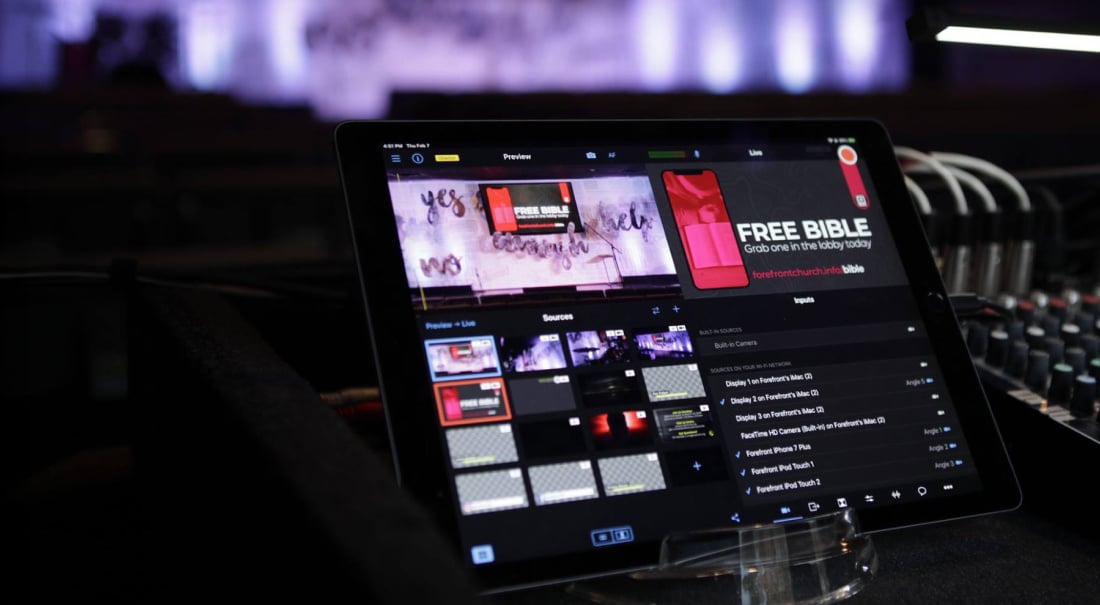
If you're venturing into the world of live streaming, you might be excited about connecting with your audience in real-time — but there's a catch.
The road to a smooth, successful broadcast is often riddled with hurdles, and without proper preparation, you can easily fall into some common live streaming mistakes. Don’t worry though, we’ve all been there — failing live! — and we’re here to help you avoid these common pitfalls. From poor video quality to underwhelming audience engagement, let's dive into seven live streaming mistakes to avoid and how you can prevent them from derailing your stream.
1. Skipping live stream planning

You want to know a trap that way too many live streamers fall into? Winging it. Good on you for finding the courage to hit "go live" and hope for the best, but if you’re hoping for a smooth, engaging stream, you’re rolling the dice. One of the biggest live streaming mistakes is failing to plan your stream properly. Not having a clear structure or an idea of what you want to accomplish can leave you fumbling through your broadcast.
So before you go live, take a few minutes (or hours) to plan. Start with a simple outline — what will your stream be about? Will you be answering questions? Doing a demo? Sharing insights on a specific topic? A well-thought-out live stream plan will keep you on track, and your viewers will appreciate the professionalism and clarity.
2. Neglecting live stream audio quality

You could have the most beautiful video quality in the world, but if your audio is terrible, people will click away faster than you can say “mic check.” Good, clear audio is essential for a great live stream. Viewers are willing to forgive a bit of blurry video or some lighting issues, but poor audio quality? That’s a dealbreaker.
If budget allows, investing in a high-quality microphone is key. Whether it's a lapel mic, shotgun mic, or even a USB condenser mic, your audio should be clear, crisp, and free from background noise. Built-in mics can be hit-or-miss, especially if you’re in a room with a lot of ambient sound. A good mic will minimize background noise and give your voice that professional touch.
Oh, and don’t set it and forget it! You should continue checking your live stream audio quality in real time. You can do this by monitoring your audio through headphones to make sure the levels are balanced and there’s no feedback or echo.
3. Struggling with a poor internet connection
One of the most frustrating live streaming mistakes is a poor internet connection.
Picture this: You’re in the middle of your live stream, giving your best performance, and suddenly your feed starts buffering, freezing, or worse — just cuts out entirely.
It's a nightmare, and it’s usually the result of a poor internet connection.
When you're streaming from a different location or hosting live stream events away from home, make sure to test the venue's internet connection ahead of time. If the connection is weak, consider using a mobile hotspot or find a backup internet solution. Having a plan in place can prevent disaster if the connection starts to falter mid-stream.
All that said, a strong and stable internet connection is your lifeline when it comes to live streaming. If you’re concerned about a weak connection, consider checking out tools like LiveU, which allows for highly reliable connections while streaming by bonding multiple internet connections simultaneously.
4. Overlooking live stream equipment
You can’t just hit "go live" and expect everything to magically look good. Live stream equipment issues are one of the most common — yet preventable — live streaming mistakes.
Start with a quality camera — something like a DSLR or mirrorless camera will give you crisp, clear video with much more control over focus and depth of field. You can even use a smartphone for streaming, but make sure it’s mounted securely and has good lighting.
Speaking of lighting, don’t skimp here! Poor lighting can make even the best camera look bad, which is why an intentional lighting setup for live streaming is non-negotiable. Use softbox lights, LED panels, or even a ring light to make sure your face is well-lit and free of harsh shadows.
And yes, we already talked about audio, but we’re going to do so again because it’s that important! A good microphone is essential. If possible, invest in an external microphone that will give your audio that clear, professional sound.
5. Failing to engage with your audience

One of the perks of live streaming is the ability to interact with your audience in real time. But if you're not actively engaging with your viewers, you might as well be talking to yourself. Live stream engagement is one of the key factors that will keep your audience coming back for more.
Make a point to acknowledge your viewers and interact with them throughout the stream. Ask questions, respond to comments, and encourage people to share their thoughts or experiences. You can even take polls or run giveaways to keep things interactive.
Live streamers who regularly interact with their audience see higher engagement rates, more viewers, and a stronger connection with their community. Don’t just talk at your audience — talk with them. Connect. This will help your audience feel like they're part of the experience, rather than just passive watchers.
6. Poor live stream promotion
You’ve got everything set up, but what if no one shows? Many streamers make the mistake of assuming that just going live is enough to pull in viewers. Spoiler — it’s not.
Promoting your stream is just as important as preparing for it. Make sure you announce your live stream well in advance on social media, your website, and through email. The more places you promote, the more chances you have that people will tune in.
Set up reminders and countdowns on your social media pages, and consider creating a short teaser video or graphic to get people excited. Cross-promote your stream across multiple platforms like TikTok, Facebook, YouTube, Instagram, and X to reach the widest possible audience. Also, encourage your audience to share your stream and spread the word. Word-of-mouth promotion is still one of the most effective ways to grow your audience.
7. Not repurposing content

So, you’ve finished your live stream (without too many hurdles cause you followed this list!), but now what? Many live streamers make the mistake of letting their content disappear into the ether. But why let it go to waste? Repurposing live stream content is a great way to maximize your hard work and keep your audience engaged after the stream ends.
Repurpose your live stream content by turning key moments into clips or uploading the full stream to platforms like YouTube. This not only extends the life of your content but also helps you reach people who might have missed the live stream. The more you repurpose, the more exposure your stream gets, and the easier it is to maintain engagement.
It’s go-live time!
We’re not saying it will go perfectly, but avoiding these seven common live streaming mistakes will help set you up for a smooth and successful broadcast. By planning ahead, investing in quality equipment, promoting your stream effectively, and engaging with your audience, you’ll create a live streaming experience that keeps viewers coming back for more.
And if you’re looking to elevate things even further, Switcher is an excellent tool for live streamers who want to take their streams to the next level. With features like multi-camera switching, real-time graphics, and the ability to stream to multiple platforms simultaneously, Switcher makes it easier than ever to create professional-quality broadcasts from anywhere. See for yourself how it can transform your streaming capabilities: Try Switcher free for 14 days.
Subscribe to the blog
Sign up to receive notifications whenever a new blog post is published. You may unsubscribe at any time.



